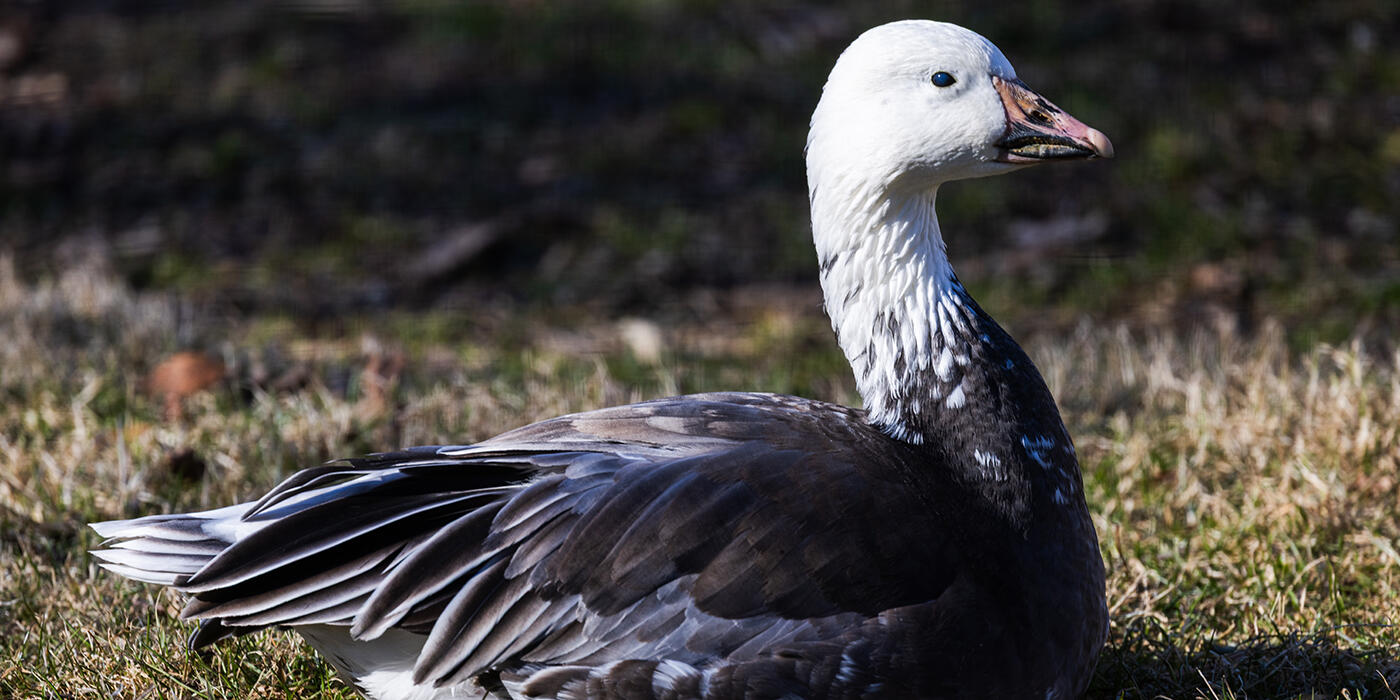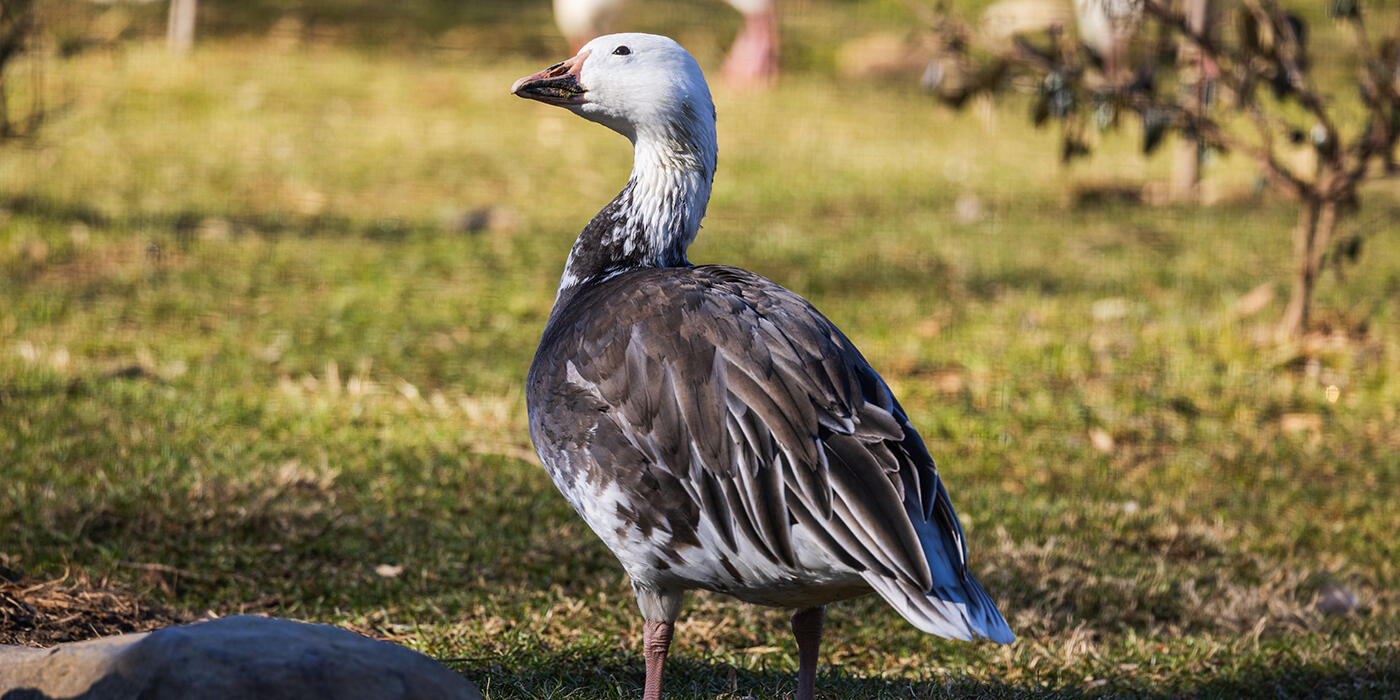These medium-sized geese breed each spring and summer in the cold, flat tundra near the Arctic Ocean. They have adapted well to living in human-dominated areas, often congregating in agricultural fields during the winter months to feed on leftover grain.
Physical Description
These geese are medium-sized, with long necks and chunky bills.
Snow geese have two main color variations – the “snow” and “blue” phases. The individuals with “snow” coloring have white plumage over most of their bodies, with black wingtips. The “blue” snow geese tend to have white faces, bodies that are some combination of dark brown, gray, or slate blue, with white spots under the tail. In both varieties, their legs and feet are red, and their bills are pink. Both forms can interbreed with each other, and babies with parents of each variety will emerge in either color form.
Size
Males are larger than females, and the greater snow geese are generally a little larger and heavier than lesser snow geese. Adults weigh between 3.5 and 7.3 pounds (or 1.6- 3.3 kilograms), and measure 25-31 inches (64-79 centimeters) in length.
Native Habitat
Their breeding grounds are in the far northern parts of North America, ranging along the Arctic coast from upper Canada and northern Alaska and even parts of Russia and Greenland. In this environment, they prefer to gather and nest in flat, featureless tundra near the Arctic Coast, often choosing areas that are free of snow and slightly elevated so the geese can spot predators from far away.
During migration periods, snow geese travel in large flocks across huge swaths of North America. As the breeding season ends, they migrate along narrow corridors each year to wetland habitats like marshes, lakes and rivers, as well as farm fields and pastures. Major wintering areas include the Atlantic Coast from Massachusetts to North Carolina, the Mississippi River Valley, the Gulf Coast and California’s Central Valley.
Lifespan
Snow geese can live for more than 25 years in the wild, if they avoid predators and hunters. Individuals have reached over 30 years old.
Communication
One of the noisiest species of waterfowl, snow geese communicate with a repertoire of vocalizations, but usually go with a loud, one-syllable “honk”. Family groups use low, guttural noises to communicate to each other while foraging. Migrating flocks call out to each other almost constantly in flight, at both daytime and nighttime.
Food/Eating Habits
Snow geese have voracious appetites and eat a wide variety of plants and vegetation. They forage by walking around in shallow water or on land, using their bills to dig up and feed on the roots of plants.
These birds burn so much energy during their seasonal migration that they eat excessively after reaching their breeding grounds: egg-laying females may spend up to 18 hours a day foraging for food. During the winter, flocks sometimes gather in agricultural fields to feast on waste grain from plowed fields.
Sleep Habits
Active mostly during the daytime; migrating flocks travel both night and day.
Social Structure
Snow geese are highly social and live year-round in flocks. These flocks can get massive – some have been recorded as ranging in the hundreds of thousands.
Reproduction and Development
Snow geese nest in large colonies along the coasts of the Arctic Ocean. Snow geese are monogamous and form pair bonds that can last for their entire lives.
Each spring, millions of snow geese migrate to their breeding grounds in the far northern reaches of North America. New mating pairs typically form before or during the annual migration. Upon reaching their breeding grounds, females choose a nest site and create a scrape in the ground. Females lay clutches of 2-6 eggs, which are creamy white to dirty gray in coloration. Nests start out simple and unrefined, but the female gradually improves their construction with soft downy feathers, sea grass, leaves, twigs, and other forms of vegetation. Meanwhile, the males guard the nests from predators.
After about 24 days of incubation, the eggs hatch. The goslings are well-developed upon hatching, as they are born with their eyes open and covered with soft downy feathers. Baby geese are capable of walking and feeding themselves just a few hours after birth. They are capable of flying after about 42-50 days, although they often remain with their parental groups until reaching sexual maturity after two or three years.
Conservation Efforts
The snow goose population has increased drastically since the early 1900s, when decades of overhunting and habitat loss had pushed their numbers to just a few thousand. Now, the overall population ranges in the millions – in fact, flocks of snow geese gather in such great numbers and feast so intensively that they can degrade their local environment and put other species of nesting shorebirds at risk.
Help this Species
Reduce, reuse and recycle — in that order! Cut back on single-use goods, and find creative ways to reuse products at the end of their life cycle. Choose recycling over trash when possible.
Be a smart consumer. Choose products made with sustainable ingredients, such as Smithsonian certified Bird Friendly coffees, which support farmers striving to limit their impact on wildlife and habitat.
Practice ecotourism by being an advocate for the environment when you’re on vacation. During your travels, support, visit or volunteer with organizations that protect wildlife. Shop smart too! Avoid buying products made from animals, which could support poaching and the illegal wildlife trade.
Organize or attend a stream, river, lake or other waterway cleanup in your area to preserve aquatic habitats for local species.
Support organizations like the Smithsonian’s National Zoo and Conservation Biology Institute that research better ways to protect and care for this animal and other endangered species. Consider donating your time, money or goods.
Are you a hunter? You can be an incredible ally for conservation! Check the conservation status of the animals you hunt and use methods that don’t impact other animals.
Smithsonian's National Zoo and Conservation Biology Institute. (n.d.). Snow goose. Retrieved November 30, 2025, from https://nationalzoo.si.edu/animals/snow-goose
Animal News

Giant Panda Qing Bao Gets a Checkup ›

7 Spooktacular Animal Facts for Halloween ›



